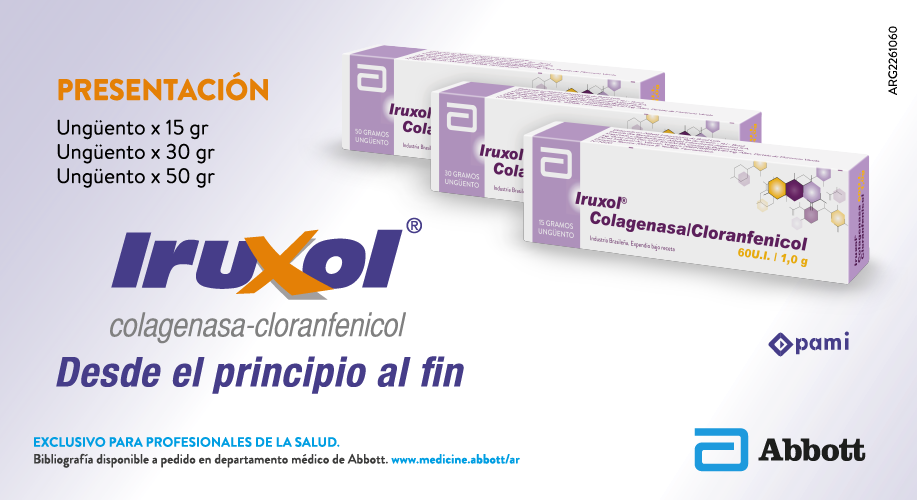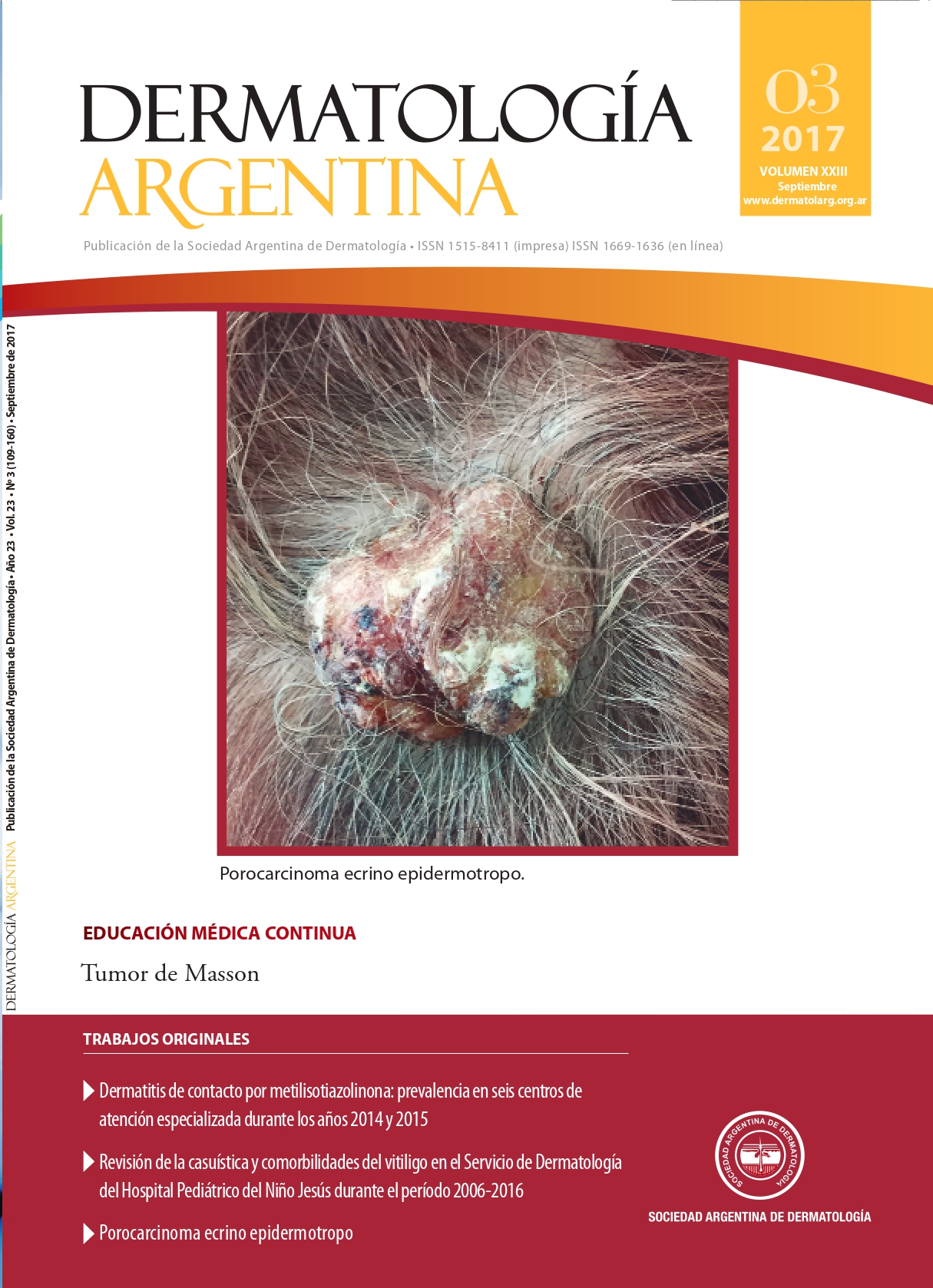Contact dermatitis to methylisothiazolinone: prevalence in six specialized care centers during the years 2014 and 2015
Keywords:
methylisothiazolinone, allergic contact dermatitis, cosmeticsAbstract
Background: methylisothiazolinone (MI) is a preservative in cosmetics and industrial products. Allergic contact dermatitis caused by MI has shown a significant increase in its frequency in recent years with different values depending on each region. The real situation in our area is not known.
Objetive: to know the percentage of sensitized to MI in patients with eczema of our population.
Design: descriptive study of prevalence.
Methods: patch tested patients were analyzed using the allergens of Latin American Standard Series in six centers specialized in contact dermatitis during the period between March 2014 and December 2015.
Results: MOAHLFA index was used to establish the organization of the results. Patch tests detected an MI sensitization rate of 15.5%. Of this percentage, 82.6% had a clinical correlation, the majority were women (71.2%) and over 40 (62%). It should be noted that in many cases there were occupational relationships, a history of atopy and the most affected topography comprised face and hands.
Conclusions: the increase in the MI sensitization rate observed by our Contact Dermatitis Research Group in Argentina ranges from 7.02% (2011-2013) to 15.5% (2014-2015) and relates to changes published by other Research centers in Europe and the United States.
References
I. Leiva-Salinas M, Francés L, Silvestre JF. Update on allergic con-tact dermatitis due to methylchloroisothiazolinone/methyliso-thiazolinone and methylisothiazolinone. Actas Dermosifiliogr2014;105:840-846.
II. Urwin R, Mark Wilkinson M. Methylchloroisothiazolinone and methylisothiazolinone contact allergy: a new epidemic. Contact Derm 2014;68:250-256.
III. Castanedo-Tardana MP, Zug KA. Methylisothiazolinone. Dermatitis 2013;24:2-6.
IV. Smith HR, Wakelin SH, McFadden JP, Rycroft RJ, et ál. A 15-year review of our MOAHLFA index. Contact Derm 1999;40:227-228.
V. Hanifin JM, Rajka G. Diagnostic features of atopic dermatitis. Acta Derm Venereol Suppl 1980;59:44-47.
VI. Hunziker N. The “Isothiazolinone story”. Dermatology 1992;184:85-86.
VII. Debeuckelaere C, Moussallieh FM, Elbayed K, Namer IJ, et ál. In situ chemical behaviour of methylisothiazolinone (MI) and methylchloroisothiazolinone (MCI) in reconstructed human epidermis: a new approach to the cross-reactivity issue. Contact Derm 2016;74:159-167.
VIII. Fonacier L, Bernstein DI, Pacheco K, Holness DL, et ál. Contact dermatitis: a practice parameter updates 2015. J Allergy Clin Immunol Pract 2015;3:652-658.
IX. Bruze M, Engfeldt M, Goncalo M, Goossens A, et ál. Recommen-dation to include methylisothiazolinone in the European base-line patch test series-on behalf of the European Society of Con-tact Dermatitis and the European Environmental and Contact Dermatitis Research Group. Contact Derm 2013;69:263-270.
X. Yu SH, Sood A, Taylor JS. Patch testing for methylisothiazolino-ne and methylchloroisothiazolinone-methylisothiazolinone contact allergy. JAMA Dermatol 2016;152:67-72.
XI. De Unamuno B, Zaragoza Ninet V, Sierra C, De la Cuadra J. Estudio descriptivo de la sensibilización a metilcloroisotiazo-linona/metilisotiazolinona en una unidad de alergia cutánea. Actas Dermosifiliogr 2014;105:854-859.1
XII. Scherrrer M, Rocha VB, Andrade A. Contact dermatitis to me-thylisothiazolinone. An Bras Dermatol 2015;90:912-914.
XIII. Vauhkala AR, Pesonen M, Suomela M, Kuuliala O, et ál. Occu-pational contact allergy to methylchloroisothiazolinone/me-thylisothiazolinone and methylisothiazolinone. Contact Derm2015;73:150-156.
XIV. McFadden JP, Mann J, White JML, Banerjee P, et ál. Outbreak of methylisothiazolinone allergy targeting those aged ≥ 40 years. Contact Derm 2013;69:53-63.
XV. Bergfeld WF, Belsito DV, Hill RA, Klaassen CD. Amended safe-ty assessment of methylisothiazolinone as used in cosmetics. cosmetic ingredient. Review. October 8, 2014. http://www.cir-safety.org/sites/default/files/mthiaz092014FR_final.pdf.Fecha de consulta: 3 de abril de 2017.
XVI. Leiva-Salinas M, Frances L, Marin-Cabanas, I. Bouret AM. Methylchloroisothiazolinone/methylisothiazolinone and me-thylisothiazolinone allergies can be detected by 200 ppm of methylchloroisothiazolinone/ methylisothiazolinone patch test concentration. Dermatitis 2014;24:130-134.
XVII. Isaksson M, Gruvberger B, Goncalo M, Goossens A. Repeated open application test with methylisothiazolinone in indivi-duals sensitive to methylchloroisothiazolinone/methylisothia-zolinone. Contact Derm 2014;70:238-260.
XVIII. Scientific Committee on Consumer Safety (SCCS). Opinion on methylisothiazolinone. Ref Ares 2015;3108730-24/7/2015.
XIX. Reglamento técnico MERCOSUR sobre lista de sustancias de acción conservadora permitidas para productos de higiene personal, cosméticos y perfumes. (MERCOSUR/GMC/Resolu-ción 07/11), 2011.
XX. Schwensen JF, White IR, Thyssen JP, Menné T, et ál. Failures in risk assessment and risk management for cosmetic preserva-tives in Europe and the impact on public health. Contact Derm2015;73:133-141. http://ec.europa.eu/health/scientific_com-mittees/consumer_safety/docs/sccs_o_178.pdf.
Downloads
Published
Issue
Section
License
Copyright (c) 2017 Argentine Society of Dermatology

This work is licensed under a Creative Commons Attribution-NonCommercial-NoDerivatives 4.0 International License.
El/los autor/es tranfieren todos los derechos de autor del manuscrito arriba mencionado a Dermatología Argentina en el caso de que el trabajo sea publicado. El/los autor/es declaran que el artículo es original, que no infringe ningún derecho de propiedad intelectual u otros derechos de terceros, que no se encuentra bajo consideración de otra revista y que no ha sido previamente publicado.
Le solicitamos haga click aquí para imprimir, firmar y enviar por correo postal la transferencia de los derechos de autor














